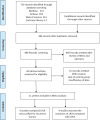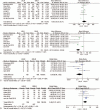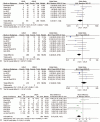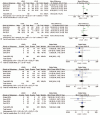Outcomes of laparoscopic repeat liver resection for recurrent liver cancer: A system review and meta-analysis
- PMID: 31593128
- PMCID: PMC6799857
- DOI: 10.1097/MD.0000000000017533
Outcomes of laparoscopic repeat liver resection for recurrent liver cancer: A system review and meta-analysis
Abstract
Background: With the improvements of surgical instruments and surgeons' experience, laparoscopic liver resection has been applied for recurrent tumors. However, the value of laparoscopic repeat liver resection (LRLR) is still controversial nowadays, which compelled us to conduct this meta-analysis to provide a comprehensive evidence about the efficacy of LRLR for recurrent liver cancer.
Methods: A computerized search was performed to identify all eligible trials published up to April 2019. This meta-analysis was conducted to estimate the perioperative data and oncological outcomes of LRLR by compared with open repeat liver resection (ORLR) and laparoscopic primary liver resection (LPLR). A fixed or random-effect modal was established to collect the data.
Results: A total of 1232 patients were included in this meta-analysis (LRLR: n = 364; ORLR: n = 396; LPLR: n = 472). LRLR did not increase the operative time compared to ORLR (WMD = 15.92 min; 95%CI: -33.53 to 65.37; P = .53). Conversely, LRLR for patients with recurrent tumors was associated with less intraoperative blood loss (WMD = -187.33 mL; 95%CI: -249.62 to -125.02; P < .00001), lower transfusion requirement (OR = 0.24; 95%CI: 0.06-1.03; P = .05), fewer major complications (OR = 0.42; 95%CI: 0.23-0.76; P = .004), and shorter hospital stays (WMD = -2.31; 95%CI: -3.55 to -1.07; P = .0003). In addition, the oncological outcomes were comparable between the two groups. However, as for the safety of LRLR compared with LPLR, although the operative time in LRLR group was longer than LPLR group (WMD = 58.63 min; 95%CI: 2.99-114.27; P = .04), the blood loss, transfusion rates, R0 resection, conversion, postoperative complications, and mortality were similar between the two groups.
Conclusions: LRLR for recurrent liver cancer could be safe and feasible in selected patients when performed by experienced surgeons.
Conflict of interest statement
The authors have no conflicts of interest to disclose.
Figures






Similar articles
-
Safety and efficacy of laparoscopic repeat liver resection and re-operation for liver tumor.Sci Rep. 2021 Jun 2;11(1):11605. doi: 10.1038/s41598-021-89864-3. Sci Rep. 2021. PMID: 34078927 Free PMC article.
-
Review of 103 Cases of Laparoscopic Repeat Liver Resection for Recurrent Hepatocellular Carcinoma.J Laparoendosc Adv Surg Tech A. 2016 Nov;26(11):876-881. doi: 10.1089/lap.2016.0281. Epub 2016 Aug 25. J Laparoendosc Adv Surg Tech A. 2016. PMID: 27560846
-
Perioperative Outcomes of Laparoscopic Repeat Liver Resection for Recurrent HCC: Comparison with Open Repeat Liver Resection for Recurrent HCC and Laparoscopic Resection for Primary HCC.World J Surg. 2019 Mar;43(3):878-885. doi: 10.1007/s00268-018-4828-y. World J Surg. 2019. PMID: 30361747
-
Analysis of perioperative outcomes following laparoscopic repeat liver resection compared to laparoscopic primary liver resection based on a single surgeon's experience: A 1:2 propensity score-matched study.Surg Oncol. 2020 Dec;35:382-387. doi: 10.1016/j.suronc.2020.09.020. Epub 2020 Oct 2. Surg Oncol. 2020. PMID: 33035786
-
Perioperative outcomes comparing laparoscopic with open repeat liver resection for post-hepatectomy recurrent liver cancer: A systematic review and meta-analysis.Int J Surg. 2020 Jul;79:17-28. doi: 10.1016/j.ijsu.2020.03.052. Epub 2020 Mar 30. Int J Surg. 2020. PMID: 32240816
Cited by
-
Outcomes and Patient Selection in Laparoscopic vs. Open Liver Resection for HCC and Colorectal Cancer Liver Metastasis.Cancers (Basel). 2023 Feb 12;15(4):1179. doi: 10.3390/cancers15041179. Cancers (Basel). 2023. PMID: 36831521 Free PMC article. Review.
-
Therapeutic Approach to Post-Transplant Recurrence of Hepatocellular Carcinoma: Certainties and Open Issues.Cancers (Basel). 2023 Nov 26;15(23):5593. doi: 10.3390/cancers15235593. Cancers (Basel). 2023. PMID: 38067299 Free PMC article. Review.
-
Clinical efficacy of laparoscopic radical hepatectomy and laparotomy for hepatocellular carcinoma and factors of postoperative recurrence.Front Oncol. 2023 Mar 22;13:1116984. doi: 10.3389/fonc.2023.1116984. eCollection 2023. Front Oncol. 2023. PMID: 37035189 Free PMC article.
-
Multimodal laparoscopic coincidence gamma imaging system for near-infrared fluorescence guided surgery: a preclinical study.J Med Imaging (Bellingham). 2023 May;10(3):033505. doi: 10.1117/1.JMI.10.3.033505. Epub 2023 Jun 21. J Med Imaging (Bellingham). 2023. PMID: 37351312 Free PMC article.
-
JDF promotes the apoptosis of M2 macrophages and reduces epithelial-mesenchymal transition and migration of liver cancer cells by inhibiting CSF-1/PI3K/AKT signaling pathway.Heliyon. 2024 Aug 2;10(15):e34968. doi: 10.1016/j.heliyon.2024.e34968. eCollection 2024 Aug 15. Heliyon. 2024. PMID: 39170340 Free PMC article.
References
-
- Tabrizian P, Jibara G, Shrager B, et al. Recurrence of hepatocellular cancer after resection: patterns, treatments, and prognosis. Ann Surg 2015;261:947–55. - PubMed
-
- Itamoto T, Nakahara H, Amano H, et al. Repeat hepatectomy for recurrent hepatocellular carcinoma. Surgery 2007;141:589–97. - PubMed
-
- Wicherts DA, de Haas RJ, Salloum C, et al. Repeat hepatectomy for recurrent colorectal metastases. Br J Surg 2013;100:808–18. - PubMed
Publication types
MeSH terms
LinkOut - more resources
Full Text Sources
Medical
Miscellaneous

